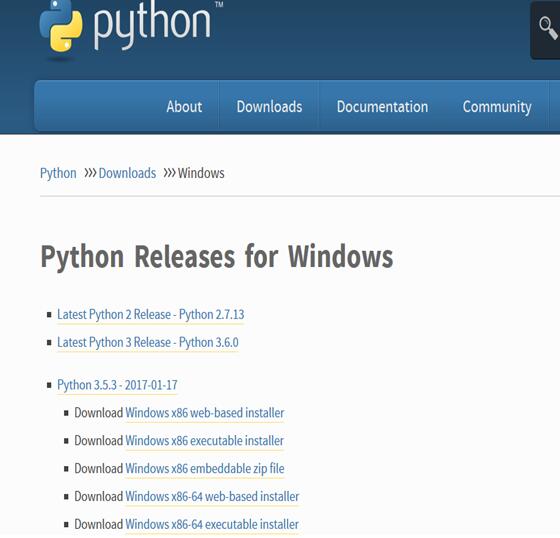Django基础之Model操作步骤(介绍)
一、数据库操作
1、创建model表
基本结构:
#coding:Utf8 from django.db import models class userinfo(models.Model): #如果没有models.AutoField,默认会创建一个id的自增列 name = models.CharField(max_length=30) email = models.EmailField() memo = models.TextField()
字段解释:
1、models.AutoField 自增列= int(11)
如果没有的话,默认会生成一个名称为 id 的列,如果要显示的自定义一个自增列,必须将给列设置为主键 primary_key=True。
2、models.CharField 字符串字段
必须 max_length 参数
3、models.BooleanField 布尔类型=tinyint(1)
不能为空,Blank=True
4、models.ComaSeparatedIntegerField 用逗号分割的数字=varchar
继承CharField,所以必须 max_lenght 参数
5、models.DateField 日期类型 date
对于参数,auto_now =True则每次更新都会更新这个时间;auto_now_add 则只是第一次创建添加,之后的更新不再改变。
6、models.DateTimeField 日期类型 datetime
同DateField的参数
7、models.Decimal 十进制小数类型= decimal
必须指定整数位max_digits和小数位decimal_places
8、models.EmailField 字符串类型(正则表达式邮箱)=varchar
对字符串进行正则表达式
9、models.FloatField 浮点类型= double
10、models.IntegerField 整形
11、models.BigIntegerField 长整形
integer_field_ranges ={
'SmallIntegerField':(-32768,32767),
'IntegerField':(-2147483648,2147483647),
'BigIntegerField':(-9223372036854775808,9223372036854775807),
'PositiveSmallIntegerField':(0,32767),
'PositiveIntegerField':(0,2147483647),
}
12、models.IPAddressField 字符串类型(ip4正则表达式)
13、models.GenericIPAddressField 字符串类型(ip4和ip6是可选的)
参数protocol可以是:both、ipv4、ipv6
验证时,会根据设置报错
14、models.NullBooleanField 允许为空的布尔类型
15、models.PositiveIntegerFiel 正Integer
16、models.PositiveSmallIntegerField 正smallInteger
17、models.SlugField 减号、下划线、字母、数字
18、models.SmallIntegerField 数字
数据库中的字段有:tinyint、smallint、int、bigint
19、models.TextField 字符串=longtext
20、models.TimeField 时间 HH:MM[:ss[.uuuuuu]]
21、models.URLField 字符串,地址正则表达式
22、models.BinaryField 二进制
23、models.ImageField图片
24、models.FilePathField文件
更多字段
参数解释:
1、null=True 数据库中字段是否可以为空 2、blank=True django的Admin中添加数据时是否可允许空值 3、primary_key =False 主键,对AutoField设置主键后,就会代替原来的自增 id 列 4、auto_now 和 auto_now_add auto_now 自动创建---无论添加或修改,都是当前操作的时间 auto_now_add 自动创建---永远是创建时的时间 5、choices GENDER_CHOICE =( (u'M', u'Male'), (u'F', u'Female'), ) gender = models.CharField(max_length=2,choices = GENDER_CHOICE) 6、max_length 7、default 默认值 8、verbose_name Admin中字段的显示名称 9、name|db_column 数据库中的字段名称 10、unique=True 不允许重复 11、db_index =True 数据库索引 12、editable=True 在Admin里是否可编辑 13、error_messages=None 错误提示 14、auto_created=False 自动创建 15、help_text 在Admin中提示帮助信息 16、validators=[] 17、upload-to 参数解释
进行数据的操作
查:
models.UserInfo.objects.all()
models.UserInfo.objects.all().values('user') #只取user列
models.UserInfo.objects.all().values_list('id','user') #取出id和user列,并生成一个列表
models.UserInfo.objects.get(id=1) #取id=1的数据
models.UserInfo.objects.get(user='rose') #取user=‘rose'的数据
增:
models.UserInfo.objects.create(user='rose',pwd='123456')
或者
obj = models.UserInfo(user='rose',pwd='123456')
obj.save()
或者
dic = {'user':'rose','pwd':'123456'}
models.UserInfo.objects.create(**dic)
删:
models.UserInfo.objects.filter(user='rose').delete()
改:
models.UserInfo.objects.filter(user='rose').update(pwd='520')
或者
obj = models.UserInfo.objects.get(user='rose')
obj.pwd = '520'
obj.save()
例举常用方法:
# 获取个数
#
# models.Tb1.objects.filter(name='seven').count()
# 大于,小于
#
# models.Tb1.objects.filter(id__gt=1) # 获取id大于1的值
# models.Tb1.objects.filter(id__lt=10) # 获取id小于10的值
# models.Tb1.objects.filter(id__lt=10, id__gt=1) # 获取id大于1 且 小于10的值
# in
#
# models.Tb1.objects.filter(id__in=[11, 22, 33]) # 获取id等于11、22、33的数据
# models.Tb1.objects.exclude(id__in=[11, 22, 33]) # not in
# contains
#
# models.Tb1.objects.filter(name__contains="ven")
# models.Tb1.objects.filter(name__icontains="ven") # icontains大小写不敏感
# models.Tb1.objects.exclude(name__icontains="ven")
# range
#
# models.Tb1.objects.filter(id__range=[1, 2]) # 范围bettwen and
# 其他类似
#
# startswith,istartswith, endswith, iendswith,
# order by
#
# models.Tb1.objects.filter(name='seven').order_by('id') # asc
# models.Tb1.objects.filter(name='seven').order_by('-id') # desc
# limit 、offset
#
# models.Tb1.objects.all()[10:20]
# group by
from django.db.models import Count, Min, Max, Sum
# models.Tb1.objects.filter(c1=1).values('id').annotate(c=Count('num'))
# SELECT "app01_tb1"."id", COUNT("app01_tb1"."num") AS "c" FROM "app01_tb1" WHERE "app01_tb1"."c1" = 1 GROUP BY "app01_tb1"."id"
常用方法
二、详解常用字段
models.DateTimeField 日期类型 datetime
参数,
auto_now = True :则每次更新都会更新这个时间
auto_now_add 则只是第一次创建添加,之后的更新不再改变。
class UserInfo(models.Model): name = models.CharField(max_length=32) ctime = models.DateTimeField(auto_now=True) uptime = models.DateTimeField(auto_now_add=True)
from app01 import models def home(request): models.UserInfo.objects.create(name='yangmv') after = models.UserInfo.objects.all() print after[0].ctime return render(request, 'app01/home.html')
表结构的修改
表结构修改后,原来表中已存在的数据,就会出现结构混乱,makemigrations更新表的时候就会出错
解决方法:
1、新增加的字段,设置允许为空。生成表的时候,之前数据新增加的字段就会为空。(null=True允许数据库中为空,blank=True允许admin后台中为空)
2、新增加的字段,设置一个默认值。生成表的时候,之前的数据新增加字段就会应用这个默认值
from django.db import models # Create your models here. class UserInfo(models.Model): name = models.CharField(max_length=32) ctime = models.DateTimeField(auto_now=True) uptime = models.DateTimeField(auto_now_add=True) email = models.EmailField(max_length=32,null=True) email1 = models.EmailField(max_length=32,default='rose@qq.com')
执行makemigrations, migrate 后。老数据会自动应用新增加的规则
models.ImageField 图片
models.GenericIPAddressField IP
ip = models.GenericIPAddressField(protocol="ipv4",null=True,blank=True)img = models.ImageField(null=True,blank=True,upload_to="upload")
常用参数
选择下拉框 choices
class UserInfo(models.Model): USER_TYPE_LIST = ( (1,'user'), (2,'admin'), ) user_type = models.IntegerField(choices=USER_TYPE_LIST,default=1)
2、连表结构
•一对多:models.ForeignKey(其他表)
•多对多:models.ManyToManyField(其他表)
•一对一:models.OneToOneField(其他表)
应用场景:
•一对多:当一张表中创建一行数据时,有一个单选的下拉框(可以被重复选择)
例如:创建用户信息时候,需要选择一个用户类型【普通用户】【金牌用户】【铂金用户】等。
•多对多:在某表中创建一行数据是,有一个可以多选的下拉框
例如:创建用户信息,需要为用户指定多个爱好
•一对一:在某表中创建一行数据时,有一个单选的下拉框(下拉框中的内容被用过一次就消失了
例如:原有含10列数据的一张表保存相关信息,经过一段时间之后,10列无法满足需求,需要为原来的表再添加5列数据
一对多:
from django.db import models
# Create your models here.
class UserType(models.Model):
name = models.CharField(max_length=50)
class UserInfo(models.Model):
username = models.CharField(max_length=50)
password = models.CharField(max_length=50)
email = models.EmailField()
user_type = models.ForeignKey('UserType')
这是UserInfo表,可以通过外键,对应到UserType表的ID

这是User_Type表的数据
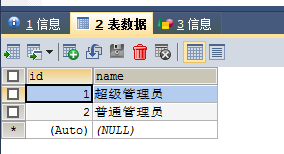
多对多:
from django.db import models
# Create your models here.
class UserType(models.Model):
name = models.CharField(max_length=50)
class UserInfo(models.Model):
username = models.CharField(max_length=50)
password = models.CharField(max_length=50)
email = models.EmailField()
user_type = models.ForeignKey('UserType')
class UserGroup(models.Model):
GroupName = models.CharField(max_length=50)
user = models.ManyToManyField("UserInfo")
Django model会自动创建第3张关系表,用于对应UserInfo_id 和UserGroup_id
UserInfo表如上所示:
UserGroup表
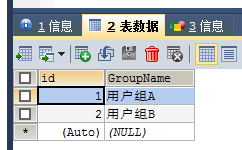
Django自动生成的对应关系表
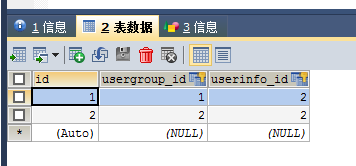
userinfo_id = 1 为 Boss,属于1(用户组A)
一对一: (一对多增加了不能重复)
from django.db import models
# Create your models here.
class UserType(models.Model):
name = models.CharField(max_length=50)
class UserInfo(models.Model):
username = models.CharField(max_length=50)
password = models.CharField(max_length=50)
email = models.EmailField()
user_type = models.ForeignKey('UserType')
class UserGroup(models.Model):
GroupName = models.CharField(max_length=50)
user = models.ManyToManyField("UserInfo")
class Admin(models.Model):
Address = models.CharField()
user_info_address = models.OneToOneField('UserInfo')
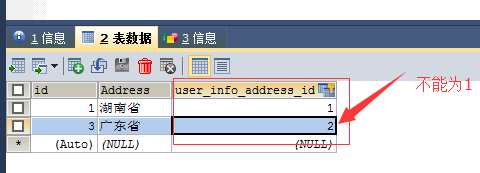
以上这篇Django基础之Model操作步骤(介绍)就是小编分享给大家的全部内容了,希望能给大家一个参考,也希望大家多多支持【听图阁-专注于Python设计】。
